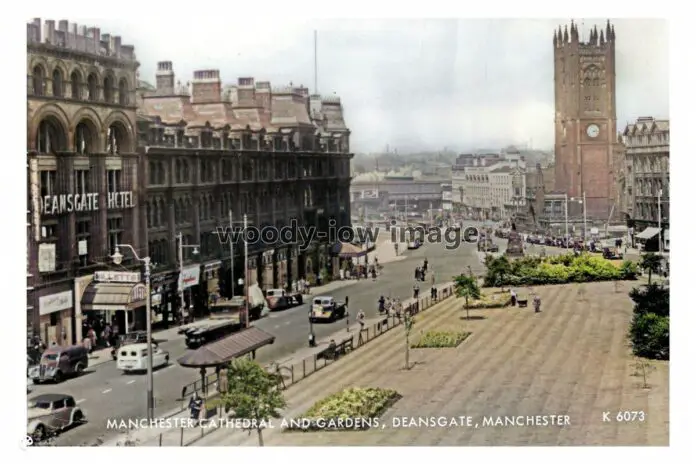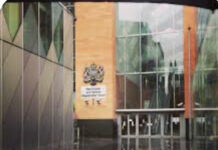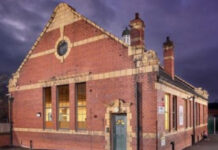While many buildings along Deansgate would succumb to the bombs of Goering’s German Luftwaffe, the life of one grand building would end in tragic circumstances in a fire that would claim sixteen lives and would provide a mystery wrapped in spying and espionage
The Denasgate Hotel opened in 1894 as a Temperence Hotel, with 100 rooms and backed onto the River Irwell
The fire started in the basement of the hotel about five o’clock in the morning of the 11 February 1942 and spread rapidly.
The register of guests at the hotel was destroyed in the blaxe but it was estimated that there were about 86 guests and 45 members of staff in the building at the time. Initially the death toll was given as five but by 21 February sixteen people were believed to have died in the blaze.
Fourteen bodies had been recovered, but only four could be positively identified. On 24 February 1942 the bodies of eight men and two women were buried in two communal graves at Southern Cemetery.
Not until 4 March was recovered at Mode Wheel the body of Ernest George Brown general secretary of the Doncaster Co-op who had jumped into the River Irwell and drowned.
The Manchester coroner a month later would blame the fire on lax fire regulations on behalf of the owners but questions about its demise had already been raised in Parliament that under wartime regulations could not be reported
The Labour MP for Westhoughton Rhys Davis would ask for a full report on the fire.
Seventeen years after the event it was claimed the blaze was the work of a Nazi agent as it was rumoured that a government official was staying in the hotel that night carrying vital plans.
The coroner revealed that the staff were told to search the documents of the dead after he had discovered that one of the guests that night who survived was Major Herbert Reginald Healey of the regional Home Security Department.
The press tracked down Major Healey from his Withington retirement, was convinced that the fire was started by a ‘fifth columnist’.
He said that the blaze bore all the signs of a thermite bomb rather than being started in the boiler room as the inquest concluded at the time.
Some of the bodies were never found including that of a civil servant said to have been connected with secret war factories in Lancashire and who was carrying vital information. The claims prompted the Manchester inquest at the time to look at the documents again but it came to nothing and the mystery has never been solved.
The hotel never re-opened. Although the ground floor shops on Deansgate were reinstated by the mid 1950s, the roofless and gutted shell of the building’s upper floors remained untouched until its final demolition in early 1971
In 1971 the site became part of the Market Place development which stretched from Market Place/ Old Millgate to the river.
On the west side of Deansgate a slab block of offices above a podium and underground car park was built in their beloved white concrete, the only remaining part of the development. For many years the building remained empty and unoccupied before part was converted into the Renaissance Hotel
Often regarded as one of the worst architectural crimes imposed on the centre of Manchester, it is now in the process of being demolished







